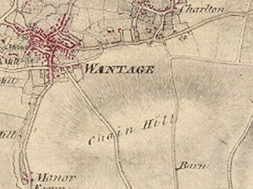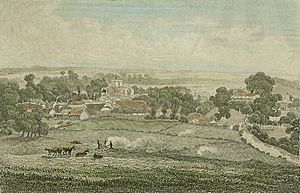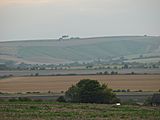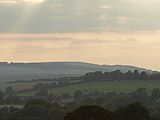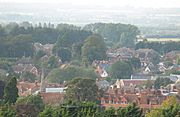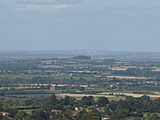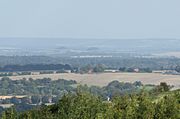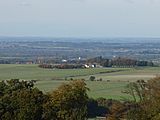Chain Hill facts for kids
Chain Hill is a beautiful hill located near the town of Wantage in Oxfordshire, England. It's part of the North Wessex Downs, which is a special area known for its amazing natural beauty. This area is so important that it's called an Area of Outstanding Natural Beauty!
Chain Hill is a chalk hill, meaning it's made of soft, white rock. It rises steeply from Wantage and is also the name of a road (the B4494) that goes up the hill towards Newbury.
At the top of the hill, you'll find a small community with groups of trees like beech, fir, and chestnut. There's also a reservoir that collects water from the chalk underground, supplying water to Wantage. Most of Chain Hill is made up of large, rolling fields where crops are grown. At the bottom of the hill, there's a cemetery and the area where the old St. Mary's School used to be.
Amazing Views from Chain Hill
When you're on Chain Hill, you can enjoy incredible 360-degree views! You can see all over Wantage and even far-off places like the Cotswolds, the Faringdon Folly (a tower on a hill), and Badbury Hill.
To the south and west, Chain Hill is surrounded by ancient hillforts (old forts built on hills). These include White Horse Hill, Ram's Hill, and Segsbury Camp. You can also see natural features around Hackpen Hill. If you look east, especially at sunrise, you might see over 40 miles away to Ivinghoe Beacon and the chalk crosses carved into the hills at Bledlow and Princes Risborough.
Chain Hill is shown on old maps from the British Library. It's known as one of the best spots to see Wantage, the Thames Valley, and the surrounding hillforts and beacons.
A Look Back in Time: History of Chain Hill
The flat areas of Chain Hill were once owned by the King as part of the Royal Estate in Wantage. This is mentioned in old writings, like the Life of King Alfred by Asser, and in the Domesday Book, which was a big survey of England made in 1086.
The name "Chain Hill" probably comes from the French word 'Chêne', which means Oak. It might have been named by French-speaking settlers a long time ago. Some people think it could have been named even earlier by Princess Judith, the daughter of a French king, around the year 856. She might have stayed in Wantage, where King Alfred was born. Over time, the name changed from 'Chayne Hill' to its current form, 'Chain Hill'.
In the mid-1800s, a man named Edward Ormond bought Chain Hill. He was a lawyer and helped the town of Wantage a lot. The road at the bottom of Chain Hill is now called Ormond Road, but it used to be known as Pidgeon Lane. Even before that, it was part of the Icknield Way, one of the oldest roads in Britain!
At the T-junction of Chain Hill and the old Icknield Way, there's a Norman arch. This arch leads to a historic spot where important meetings, called the Witan, might have happened around 995. Later, this site was used by a convent and became St Mary's School.
Discoveries from the Past: Archaeology
People have found old coins and other items at the top of Chain Hill. These finds show that people lived there from the late Iron Age all the way through to Medieval times.
One special find was a coin from Æthelwulf of Wessex, who was King Alfred's father. This coin was made between 848 and 851, which is around the time Alfred was born in Wantage. Because of this connection, the find was considered very important by the Portable Antiquities Scheme, which records archaeological finds made by the public.
Nature on Chain Hill
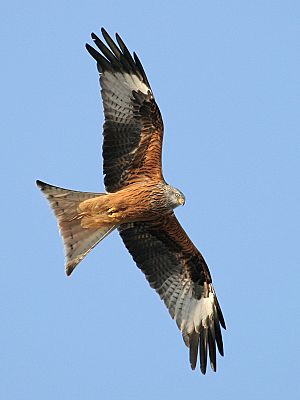
Chain Hill is part of the Southern England Chalk Formation, which is a unique natural area. The chalky countryside here is home to many different kinds of butterflies and wildflowers. You can see flowers like cowslip, orchids, thistles, and daisy.
The mixed farmland on the hills supports a wide variety of birds. You might spot yellowhammers, corn buntings, common linnets, northern wheatears, whinchats, yellow wagtails, lapwings, red kites, and sparrowhawks. You might even see barn owls, pheasants, grey partridges, stock doves, and skylarks.
Animals like Roe deer, Reeve's muntjac (a small type of deer), and red foxes are also regular visitors to Chain Hill. They can often be seen in their natural homes all along the hill.
Events at Chain Hill
Every year on Easter Monday, a special horse racing event called the Old Berks Point to Point takes place further up Chain Hill, near West Lockinge. This exciting steeplechase racing event is put together by about 125 local volunteers. It attracts between eight and ten thousand spectators, making it one of the biggest horse racing events in the area each year!
Images for kids
- Chain Hill Panorama


